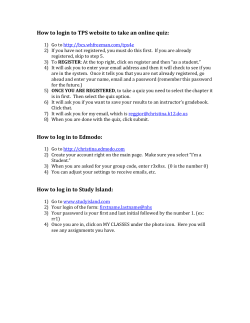
1301W.500 Sample Quiz 3 Fall 2009
1301W.500 Sample Quiz 3 Fall 2009 University of Minnesota 1 × 11 cribsheet is allowed, as well as calculators. No textbooks or notebooks. 2 This test carries 25 points which will be combined with individual test to give a grand total of 100 points. Useful information: The acceleration due to gravity is 9.8 m/s2 One 8 3.g. A spring whose constant k = 343 N/m is supported so that it hangs vertically. A mass of 70 kg is attached to the unstretched spring and released from rest so that it moves vertically. At the instant when it was released the mass was a vertical height of 4 m above the floor. (a) Does the mass reach the floor and if so with what velocity? (b) At what height above the floor is the speed of the mass a maximum and what is that speed? (c) Suppose the set-up is the same as above, but the 70 kg mass is replaced by a 50 kg mass. At what heights above the floor is the mass instantaneously at rest? (Hint: It is not necessary to do so, but you may find it useful to measure distances from the point where the mass would be at rest in equilibrium.) 1301W.500 Sample Quiz 3 Fall 2009 University of Minnesota 1 × 11 cribsheet is allowed, as well as calculators. No textbooks or notebooks. 2 Problems 1 and 2 carry 25 points each and the five multiple choice problems carry 5 point each. Attempt all problems. Work problems 1 and 2 in the space provided; the proctor will give you extra paper if you need it. Give the answers to the multiple choice problems on the General Purpose Answer Sheet or “Bubble Sheet” provided. Put your name, ID number and the number of your recitation section on each page. One 8 Useful information: g = 9.8 m/s2 = 32 ft/s2 1301W.500 Sample Quiz 3 Fall 2009 University of Minnesota Name: ID No: (last name TA Name: first name) 3.1. The picture shows a horizontal force, Fp=150 N, which pushes the 20 kg block 5 m up the 30˚ frictionless, inclined plane. (a) How much work is done by the force Fp?; by gravity?; by normal force? (b) If the block starts from rest, what is its speed at the end of the 5 m displacement? (c) What is the average power developed by the force Fp? 20 kg Fp=150N 30˚ 1301W.500 Sample Quiz 3 Fall 2009 University of Minnesota Name: ID No: (last name TA Name: first name) 3.2. Hockey puck #1 moving at 20 m/s makes an off-center elastic collision with an identical hockey puck, #2, that is at rest on horizontal, frictionless ice. Puck #1 is deflected at an angle of 20˚ from its original direction of motion. Find the velocity of pucks #1 and #2 after the collision, including the direction in which #2 moves. (If you use a special relation for the angles in equal mass elastic collisions, prove it to receive bonus points) 1 1301W.500 Sample Quiz 3 Fall 2009 University of Minnesota 3.m. Multiple choice answers are marked on the “Bubble Sheet” (1) A particle moves 5 ft in the +x direction while being acted on by a constant force → F = (4i + 2 j ) lb. The work done on the particle by the force (in ft·lb) is: (a) 20 ; (b) 10 ; (c) -10 ; (d) -20 ; (e) 30 (2) A force acting on a particle is called conservative if: (a) its work is zero when the particle moves around a closed path returning to its initial position (b) its work equals the change in kinetic energy of the particle (c) its work equals the change in total mechanical energy of the particle (d) it obeys Newton’s third law (e) it is not a frictional force (3) A block is released from rest at point P and slides along the frictionless track shown. At point Q its speed is: P (a) 2 g h1 − h2 (b) 2 g (h1 − h2 ) Q (c) (h1 − h2 ) /( 2 g ) h1 (d) 2 g (h1 − h2 ) h2 (e) (h1 − h2 ) 2 /( 2 g ) (4) A particle of mass 6 kg is located at coordinates (x, y) = (1, 3), a second particle of mass 5 kg is at (3, 2) and a third particle of mass 4 kg is at (0, 0). All distances are in meters. The coordinates of the center of mass, (xCM, yCM), of the three particles are: (a) (0, 0) ; (b) (1.3, 1.7) ; (c) (1.4, 1.9) ; (d) (1.9, 2.5) ; (e) (1.4, 2.5) (5) A 2000 kg flatcar moves horizontally without friction with a velocity of 3 m/s. As shown a 500 kg sack of coal is dropped vertically onto the flatcar. When the sack is at rest on the flatcar, the speed of the flatcar is: (a) 4 m/s (b) 2.4 m/s (c) 1.2 m/s (d) 1.8 m/s (e) impossible to say without more information
© Copyright 2025





















